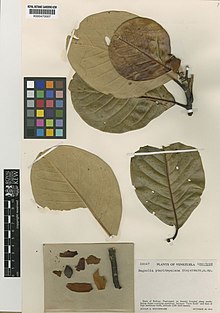Magnolia ptaritepuiana is a species of flowering plant in the family Magnoliaceae. It is endemic to the tepuis, flat-topped mountains in southern Venezuela and southwestern Guyana.[1]
| Magnolia ptaritepuiana | |
|---|---|

| |
| Scientific classification | |
| Kingdom: | Plantae |
| Clade: | Tracheophytes |
| Clade: | Angiosperms |
| Clade: | Magnoliids |
| Order: | Magnoliales |
| Family: | Magnoliaceae |
| Genus: | Magnolia |
| Section: | Magnolia sect. Talauma |
| Subsection: | Magnolia subsect. Dugandiodendron |
| Species: | M. ptaritepuiana
|
| Binomial name | |
| Magnolia ptaritepuiana Steyerm. (1951)
| |
| Synonyms[2] | |
| |
Description
editMagnolia ptaritepuiana is a tree which grows up to 20 meters tall.
Range and habitat
editMagnolia ptaritepuiana is known from five locations, including on the Ptari-tepui, Mount Roraima, and Sierra de Maigualida in southern Venezuela, and in the adjacent Cuyuni-Mazaruni region of Guyana. The species' estimated area of occupancy (AOO) is 16 km2 and its estimated extent of occurrence (EOO) is 28,853.27 km2.[1]
It grows in dense montane tepui forests on sandstone soils, together with species of Vismia and Euterpe, between 1,600 and 2,300 meters elevation.[1]
Conservation
editThe species' conservation status is assessed as endangered. It has a limited range, and is threatened with habitat loss and degradation from mining and poorly controlled tourism. Accelerating climate change could disrupt the montane climate of its native region and further endanger the species.[1]
References
edit- ^ a b c d e Echevarría, G. 2021. Magnolia ptaritepuiana. The IUCN Red List of Threatened Species 2021: e.T193994A152352501. https://dx.doi.org/10.2305/IUCN.UK.2021-3.RLTS.T193994A152352501.es. Accessed 1 February 2023.
- ^ Magnolia ptaritepuiana Steyerm. Plants of the World Online, Kew Science. Accessed 8 September 2024.
